Did you miss one of our industry webinars? No worries. Click the Watch this Webinar button below the description to watch any of these recordings on demand at your convenience.
If you have a topic you'd like to see us cover in a future webinar, if so click on please let us know!
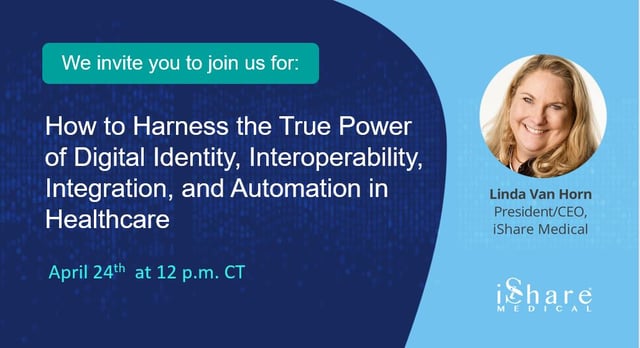
We invite you to join us on Wednesday April 24, 2024 at 12 pm CT for a complimentary webinar "How To Harness The True Powers of Digital Identity, Interoperability, Integration, and Automation in Healthcare" where we will be discussing how these tools are being used to revolutionize healthcare by:
1. Streaming patient registration enhancing efficiency, improving convenience, and reducing administrative burden
2. Improving care coordination by enabling bidirectional communications among identity-proofed providers and payers
3. Seamlessly integrating and reconciling data sent to the provider into the patients chart at the point of care
4. Workflow automation of tasks to reduce provider and staff burden and lower cost
5. Enhanced security and reduce identity fraud through digital identity and authentication
This is one webinar that you won't want to miss!
Recorded on April 24, 2024 at 12 pm CT
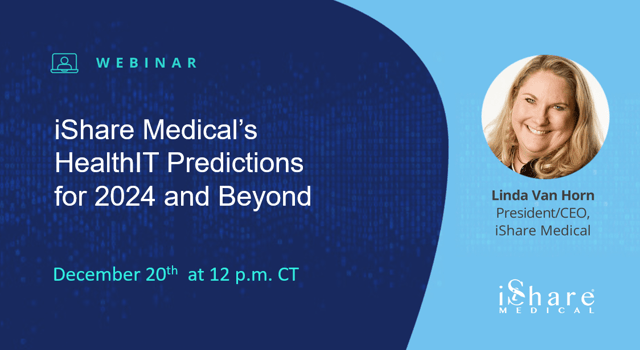
As we gear up for the approaching new year, we're excited to bring you a special event that has become an annual tradition at iShare Medical. Join us for a thought-provoking session as our Founder and President/CEO, Linda Van Horn, BS, MBA, shares her insightful Health IT predictions for 2024 and beyond.
In this exclusive webinar, we'll reflect on the predictions made last year and provide valuable updates based on the developments over the past year. Then Linda will unveil new predictions that are set to shape the landscape of Health IT in the coming years.
Don't miss out on the opportunity to gain fresh perspectives and stay ahead of the curve.
Recorded on December 20, 2023, at 12 pm CT.
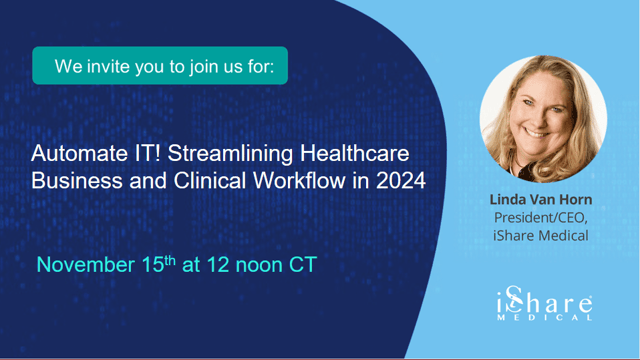
Are you tired of drowning in paperwork, redundant processes, and endless administrative tasks? Then it’s time to Automate IT!
This webinar discusses the benefits of workflow automation and provides specific healthcare use cases that can help you optimize workflow, reduce errors, streamline provider and staff productivity, and reduce cost by eliminating otherwise manual tasks.
It’s time to Automate IT!
Recorded on November 15, 2023, at 12 pm CT.
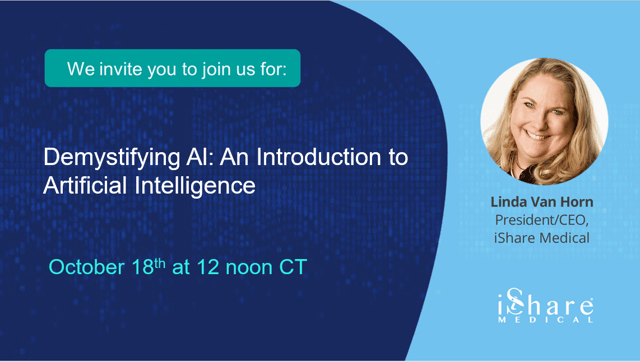
This webinar discussed the key components of Artificial Intelligence including Artificial Intelligence (AI), Machine Learning (ML), and Deep Learning (DL) also known as Neural Networks (NN). We watched a short video of an Automaton and showed an example of teaching a machine to play Tic-Tac-Toe using a Neural Network and the Minimax Algorithm.
We explored examples of AI and dug a little deeper into the emerging field of Generative AI and Foundation Models. Then we reviewed how AI, ML, and NN are being used in Healthcare and ended with a fun demonstration video from Boston Dynamics of some very leading-edge technology.
Recorded on October 18, 2023, at 12 pm CT.
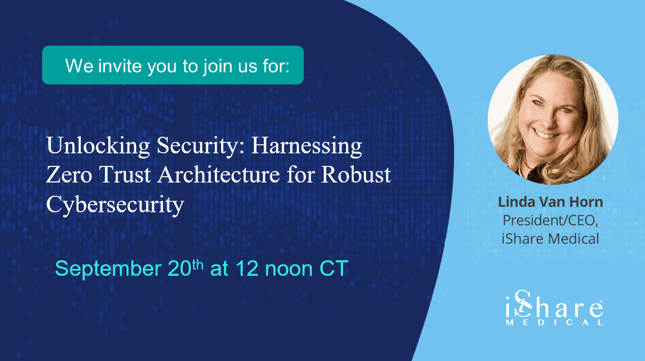
𝗭𝗲𝗿𝗼 𝗧𝗿𝘂𝘀𝘁 𝗔𝗿𝗰𝗵𝗶𝘁𝗲𝗰𝘁𝘂𝗿𝗲 (𝗭𝗧𝗔) is a cybersecurity framework and approach to network and data security that emphasizes a strict "never trust, always verify" mindset. The core principle of Zero Trust is to assume that threats could exist both outside and inside the traditional network perimeter, and therefore, no entity, whether internal or external, should be automatically trusted by default.
Traditionally, security models have relied on the concept of a trusted internal network and a less trusted external network (like the Internet). Zero Trust challenges this assumption and suggests that trust should not be determined solely by network location. Instead, it advocates for verifying the identity of users, devices, and applications before granting access to resources, regardless of their location.
Recorded on September 20, 2023, at 12 pm CT.
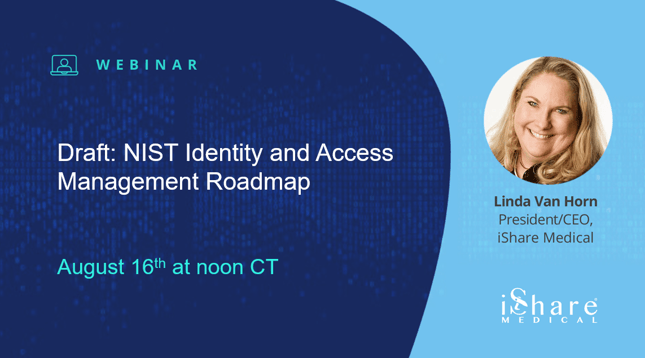
Recently there has been a lot of discussion in healthcare regarding digital identity including identity proofing, authentication, and access. Perhaps you’ve heard these acronyms being thrown around IAL2, AAL2, NIST 800-63-3, NIST 800-63-4, IdP, CSP, mDL, federation, and trust credential, but are not sure what they mean. Confused? You are not alone.
This webinar will demystify these terms and provide insights into the NIST Draft Identity and Access Management Roadmap published on April 21, 2023, and what it means in health care. This Roadmap is NIST’s strategic vision for Identity and Access Management that is foundational for the future of cyber security, interoperability, and establishing trust in order to create a modern secure digital infrastructure in the U.S. This Roadmap covers identity proofing, fraud mitigation, authentication, biometrics, digital trust credentials including mDL (mobile drivers license), and federation for both enterprise and public-facing use cases.
The National Institute of Standards and Technology (NIST) was founded in 1901 and is an agency under the U.S. Department of Commerce. NIST’s mission is “to promote U.S. innovation and industrial competitiveness by advancing measurement science, standards, and technology in ways that enhance economic security and improve our quality of life.” NIST sets the standards for the U.S. for identity verification and authentication. These standards are adopted by Federal Agencies including the Transportation Security Administration (TSA), Department of Homeland Security (DHS), and Health and Human Services (HHS) as well as the private sector including transportation, banking, finance, and healthcare.
Recorded on August 16, 2023, at 12 pm CT.
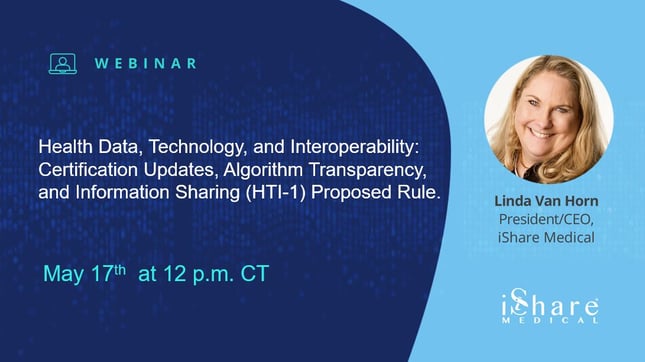
Get ready for the health IT changes that lie ahead in the next two years. The webinar entitled Health Data Technology and Interoperability HTI-1 Proposed Rule discusses the key provisions of the proposed rule and how they may affect healthcare organizations, providers, payers, and patients. We also explored the importance of interoperability in healthcare and how it can help you to improve patient outcomes and reduce costs.
We also shared our insights and answered questions from the audience, so it’s a great way for you to gain valuable industry knowledge.
Recorded on May 17, 2023, at 12 pm CT.
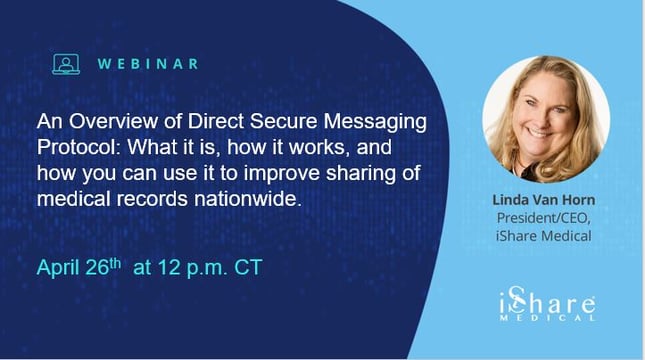
The other day I was talking with an employee of a multi-billion-dollar company about how they get medical records from providers. He explained that they first try FHIR, and if that doesn’t work then try to use several regional HIE’s, and if that doesn’t work, they use Direct Protocol because everyone supports Direct Protocol. I inquired; why don’t you start with Direct Protocol? He replied, “I really don’t know.”.
Find out why Direct Protocol is the most widely adopted protocol in secure, encrypted health information exchange. In this webinar we will discuss:
3. How you can use it to improve sharing of medical records nationwide
Recorded on April 26, 2023, at 12 pm CT.
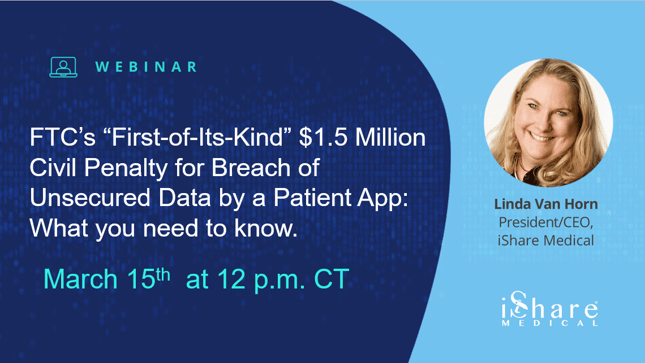
Do you think that patient apps are immune from compliance with the Breach Notification Rule? Think again. The FTC just filed a "First-of-Its-Find" $1.5 million civil penalty for breach of unsecured data by a patient app. This commonly used patient app beached data on more than 55 million customers. For the first time, the Federal Trade Commission (FTC) has exercised its enforcement rights under the Health Breach Notification Rule to impose a fine for failing to notify customers and others of its unauthorized disclosure of their personal health information.
Samuel Levine, Director of the FTC's Bureau of Consumer Protection stated that "Digital health companies and mobile apps should not cash in on consumers' extremely sensitive and personally identifiable health information," and that "The FTC is serving notice that it will use all of its legal authority to protect American consumers' sensitive data from misuse and illegal exploitation."
Bonus added a second Civil Penalty case:
Then on March 2, 2023, the FTC entered into another proposed settlement regarding the Health Breach Notification Rule but this time the settlement was larger - $7.8 million and it involved a HIPAA Covered Entity.
What? The Federal Trade Commission (FTC), a consumer protection agency, has reached a proposed settlement with a HIPAA Covered Entity? But isn’t HIPAA regulated by the Office of Civil Rights (OCR)? Yes, but …
This webinar discusses both settlements and explains what both App Vendors and Covered Entities need to know about these recent FTC settlements.
Recorded on March 15, 2023, at 12 pm CT.
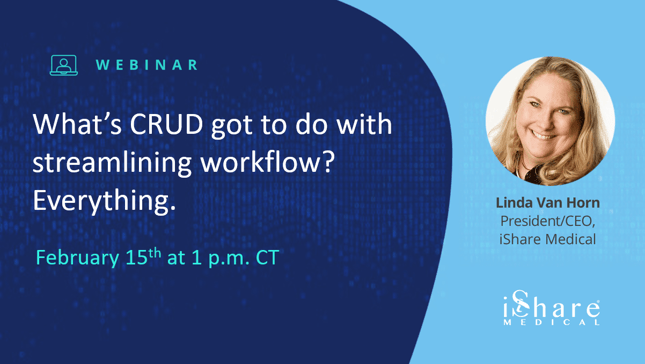
True healthcare interoperability is the ability to seamlessly and bidirectionally share information that can be used by the receiving system. This includes CRUD. CRUD is an IT acronym that standards for Create, Read, Update, and Delete. Today, most APIs are implemented as read-only queries. In this webinar, we will discuss how CRUD (ok really CRU because we don't delete information from a medical record) operations are being implemented to open up a new level of interoperability and possibility that can help you to streamline workflow, improve accuracy, and reduce cost.
Recorded on February 15, 2023, at 1 pm CT.
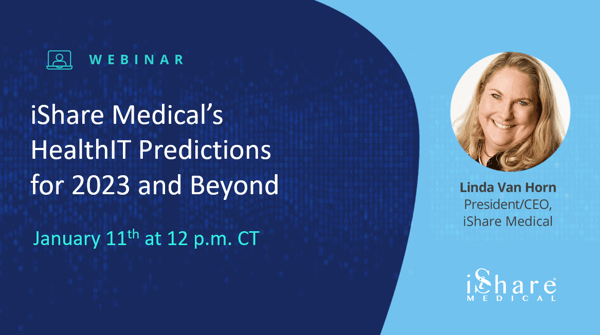
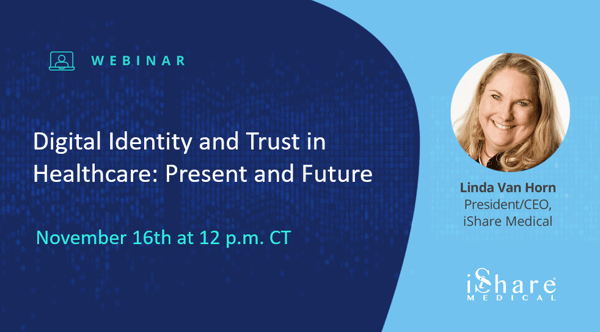
Drs. Makary and Daniel of Johns Hopkins University School of Medicine found that preventable medical errors are the third-leading cause of death in the U.S. behind heart disease and cancer[1]. This is in large part due to incomplete information and poorly coordinated care.
Patients' medical records in the US are stored based on the provider such as the hospital or doctor. Then the healthcare industry tries to match the patient’s information with other organizations using the patient’s name and date of birth. If you take one this away from this webinar know that your doctors often do not know about the care you are getting at other places because they don’t have a verifiable digital identity that can be used to provide certainty of your identity across care settings, providers, or EHR systems.
In this webinar, we will review the 3 Protocols and 6 Frameworks that are used in healthcare, we dig a little deeper into patient matching and how it differs depending upon the Framework, then we will look into the near-term and longer-term future of digital identity in US healthcare.
Source: [1] Martin Makary, MD, MPH and Michael Daniel, MD Johns Hopkins University School of Medicine BMJ 2016;353:i2139 doi: 10.1136/bmj.i2139
Recorded on November 16, 2022, at 12 pm CT.
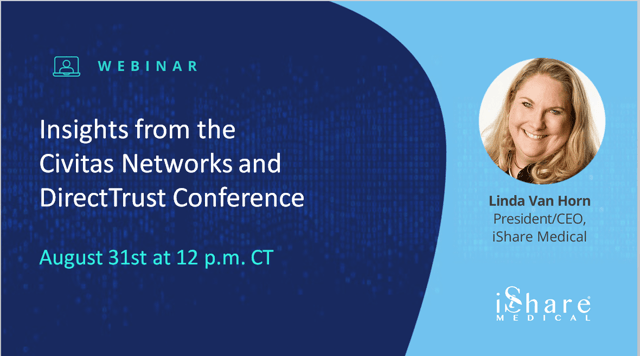
Approximately 800 people gathered in San Antonio and virtually for the first Civitas Networks and DirectTrust Conference.
Find out what you missed in this complimentary webinar on the insights from this conference including the following topics:
Recorded on August 31, 2022 at 12 pm CT.
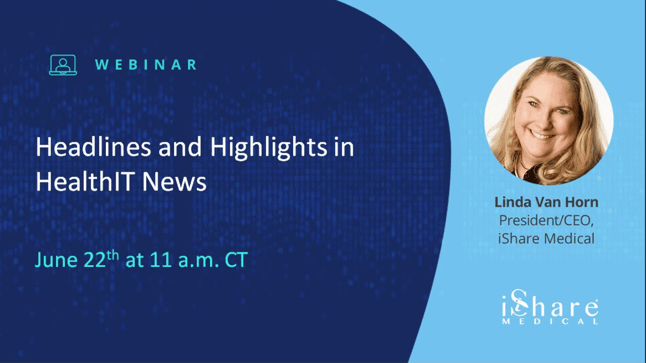
HealthIT is constantly changing. Each month, we bring you the latest update on one hot topic in Health IT. But sometimes there is more than one topic to discuss.
In this webinar, we will share insights on current hot topics so you can get ready for what lies ahead. This includes:
- Insights from the ONC Study on Variances in Interoperability
- Analysis of Hospital Use of Interoperability Methods
- Privacy Enhancing Health Record Locator Services (PEHRLS)
- HHS Strategy to Address Social Determinants of Health (SDoH)
- Trusted Exchange Framework and Common Agreement (TEFCA) Update
Recorded on June 22, 2022 at 12 pm CT.
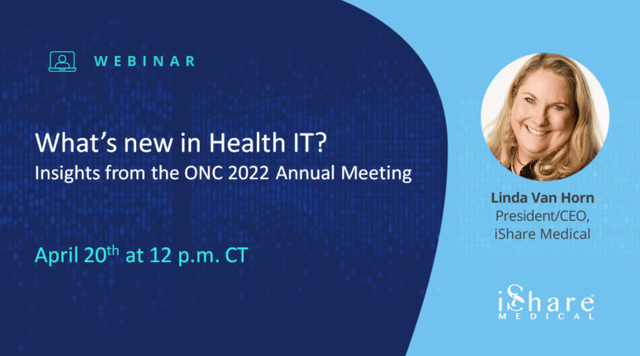
Each year the Office of National Coordinator for Health Information Technology (ONC) convenes industry stakeholders to learn about changes in ONC health IT certification and national health IT policies driving health care change in the United States. This year there was so much to communicate that the ONC broke the meeting into two two-day events.
In this webinar we will share key insights into the future of Health IT from the ONC's 2022 Annual Meeting to you can get ready for what lies ahead including:
1 Health Equity by Design
Recorded on April 20, 2022 at 12 pm CT.
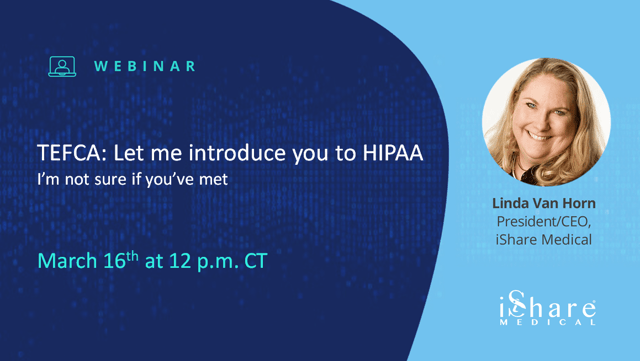
TEFCA: Let me introduce you to HIPAA I’m not sure if you’ve met …
On January 18, 2022, the ONC announced the publication of the long-awaited TEFCA v1 (Trusted Exchange Framework and Common Agreement version 1). In this webinar, we will review TEFCA through the lens of HIPAA (the Health Insurance Portability and Accountability Act of 1996).
Although HIPAA has been around for decades, it is much misunderstood. With few exceptions, patients have always had the right to get access to their medical records. What HIPAA defined was the rights of others who were not the patient had to get access to the patient’s medical records. And, HIPAA also defined when patient consent is required.
This webinar will discuss:
Recorded on March 16, 2022 at 12 pm CT.
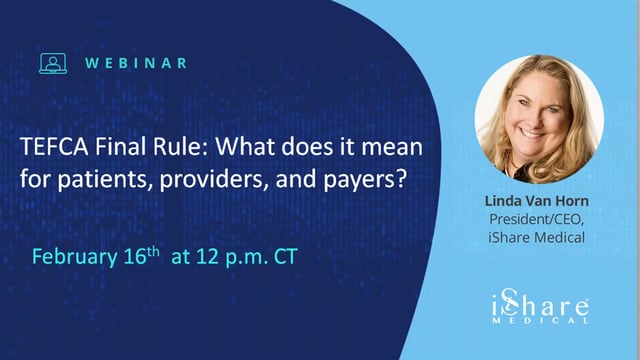
TEFCA Final Rule: What does it mean for patients, providers, and payers?
On January 18, 2022, the ONC announced the publication of the long-awaited final rule for the Trusted Exchange Framework and Common Agreement.
TEFCA has been five years in the making. On December 13, 2016, the 21st Century Cures Act was passed into law. The 21st Century Cures Act mandated that the Office National Coordination for Health Information Technology (ONC) create a new technical and legal framework for a single on-ramp for secure sharing of protected health data nationwide among patients, providers, payers, and public health. In addition, another key component in these rules was the ability for patients to get electronic access to their medical records.
TEFCA v 1 has two parts:
Since the CMS Patient Access Final Rule (CMS-9115-F) required the use of the FHIR (Fast Healthcare Interoperability Resources) protocol for the Patient Access APIs, many thought that the TEFCA technical framework would be based on the FHIR (Fast Healthcare Interoperability Resources) protocol. However, TEFCA’s technical framework is based on the iHE (Integrating the Health Enterprise) protocol. That said, the ONC recognized the importance of having a migration plan to FHIR, and therefore created a third document:
3. The FHIR Roadmap for TEFCA Exchange Version 1.
Micky Tripathi, PhD, MPP, the National Coordinator for Health Information Technology, U.S. Department of Health and Human Services stated in a Press Release that:
“Operationalizing TEFCA within the Biden Administration’s first year was a top priority for ONC and is critical to realizing the 21st Century Cures Act’s goal of a secure, nationwide health information exchange infrastructure,” and that “Simplified nationwide connectivity for providers, health plans, individuals, and public health is finally within reach.".
This webinar:
- Provides background on the 21st Century Cures Act,
- Discusses what has changed from TEFCA Draft 2, and
- Provides an overview of TEFCA v 1 including the TEFCA Common Agreement, TEFCA Technical Framework, and TEFCA FHIR Roadmap and
- Discusses what it means to patients, providers, and payers.
Recorded on February 16, 2022 at 12 pm CT.
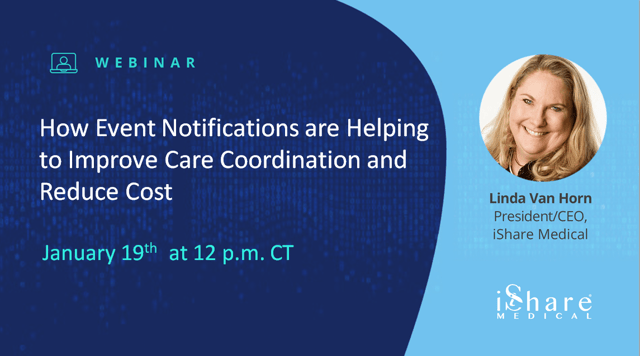
Real-time, automated, and “always-on” Event Notifications are critical to inform providers of a recent care occurrence that could impact a patient's care. In this complimentary webinar, we will discuss how hospitals, medical practices, and payers were using Event Notifications to help improve care coordination and reduce costs.
The Event Notifications via Direct Standard was developed to address the new CMS requirement that, as a condition of participation, all hospitals including critical access hospitals and psychiatric hospitals must send an HL7 2.5.1 event notification in real-time whenever a patient is admitted, charged, or transferred to or from a hospital. This standard requires that Event Notification messages be sent in both machine-readable and human-readable format, improving readability.
On January 10th the ONC announced the 2022 ISA (Interoperability Standards Advisory) Reference Edition which includes the new Event Notifications via the Direct Standard.
This webinar discusses the Event Notification via Direct Standard and provides specific examples of how hospitals, medical practices, and payers were using Event Notifications to help improve care coordination and reduce cost.
Recorded on January 19, 2022 at 12 pm CT.
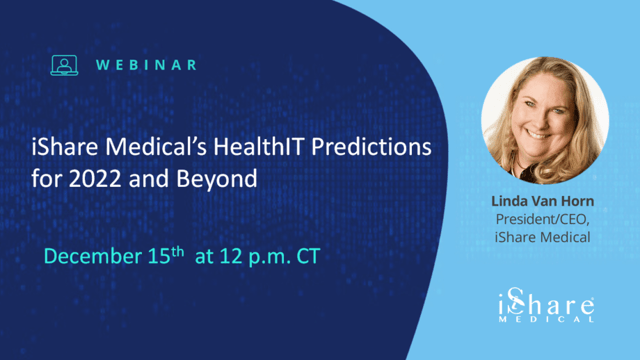
We believe that 2022 will continue the move towards radical interoperability among healthcare stakeholders such as:
This radical interoperability is critical to the success of new payment and care models that seek to improve care and outcomes and reduce cost.
In this webinar, we will give you an update on the predictions that we made for 2021 and discuss iShare Medical's 12 HealthIT Predictions for 2022 including digital identity, wearable devices, internet of things, radical interoperability, artificial intelligence, machine learning, trained neural networks, “always on” secure sharing of data, cognitive computing, and API’s. Plus we reveal the technologies that we believe will be driving disruption and innovation in 2022 and beyond.
Recorded on December 15, 2021 at 12 pm CT.
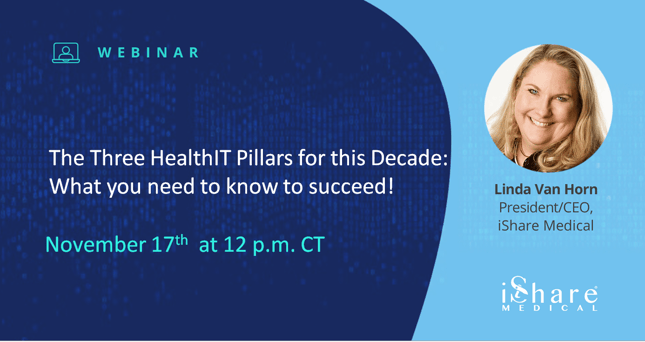
2020 began a new decade of transformation in healthcare one that moves away from siloed data to radical interoperability. This future is based on three HealthIT pillars that are the foundation needed to support new payment and care models, they are:
1. Digital Identity
2. Interoperability
3. Learning Health System
This webinar discusses these three pillars three HealthIT pillars that are the foundation for this decade to build a better, more cost-effective, and efficient health system and what you need to know to succeed!
Recorded on November 17, 2021 at 12 pm CT.
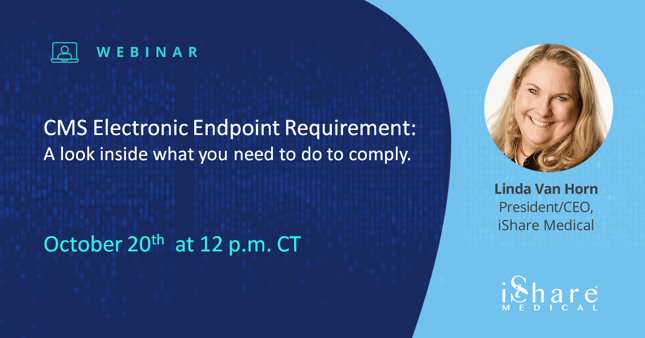
The 21st Century Cures Act required that the Department of Health and Human Services establish a Directory of Provider Electronic Endpoints in order to facilitate patient access and secure exchange of medical records. In response, CMS developed and published the Patient Access Final Rule. This Rule applies to plans controlled by CMS such as Medicare, Medicaid, Medicare Advantage, CHIP, and Qualified Health Plan issuers on the Federally-facilitated Exchanges.
This webinar will discuss the new CMS Requirements for Electronic Endpoints and how these electronic endpoints are used to support other requirements in Patient Access Final Rule such as:
We will explain what an electronic endpoint is (and is not), how to get one, how to submit your endpoint to CMS, the consequences of not complying, and how an electronic endpoint can help us streamline clinical and business workflows.
Recorded on October 20, 2021 at 12 pm CT.
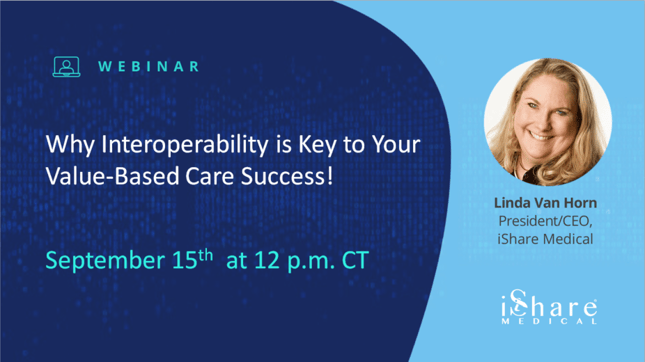
U.S. health care spending in 2019 grew 4.6%, reaching $3.8 Trillion or 17.7% of the nation’s Gross Domestic Product (GDP). This is a whopping $11,582 per person or $965 per person per month; every month.
This is more per capita than any other country in the world, yet the U.S. ranks 37th out of 191 countries per the World Health Organization on the quality of care delivered, proving that higher costs don’t result in higher quality.
At first, the U.S. tried to tackle this problem by slashing costs and increasing reporting requirements which created financial stress on providers due to reduced reimbursement and increased unfunded mandates. To combat the reductions in income and increased costs, providers increased volume driving up costs even further. Then, the U.S. realized that incentives must be aligned to drive the desired outcomes: to improve care, increase quality, and reduce cost.
Now, the U.S. is in the process of transforming health care to new payment and care models that focus on increasing value, not volume. Value-based care is health care that reduces cost while simultaneously improving care and outcomes.
To do this, we need data, lots of data. This data can be analyzed to help providers to detect, prevent, and treat medical conditions sooner resulting in improved care, better outcomes, and reduced cost. In addition, it also requires automation of workflows to reduce provider burden.
This webinar explores why interoperability is key to your value-based care success!
Recorded on September 15, 2021 at 12 pm CT.
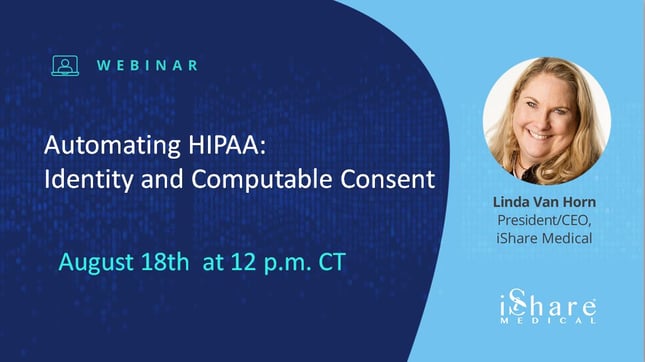
Automating HIPAA: Identity and Computable Consent
Patients have the right to access their own data and the right to share that data with those to whom they choose. Providers and payers, known under HIPAA as Covered Entities and their Business Associates have rights granted to them under HIPAA to access the patient’s medical record.
Historically, consent has been largely a manual process.
In this webinar, we will discuss patient identity, consent, and HIPAA rights of access for Covered Entities and their Business Associates. Then we will dig deeper into how these processes are being automated with computable consent.
Recorded on August 18, 2021 at 12 pm CT.
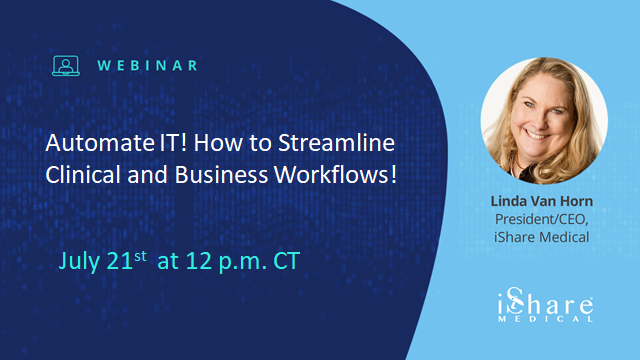
Automate IT! How to Streamline Clinical and Business Workflows!
Workflow automation is the ability to use technology to automate manual processes based on a pre-defined set of business rules with the goals of reducing errors, improving productivity, and standardizing processes. These business rules are normally initiated when a triggering event occurs and can be used to automate straightforward or complex processes.
This webinar will discuss what workflow automation is and how you can start automating your clinical and business workflows today!
Recorded on July 21, 2021 at 12 pm CT.
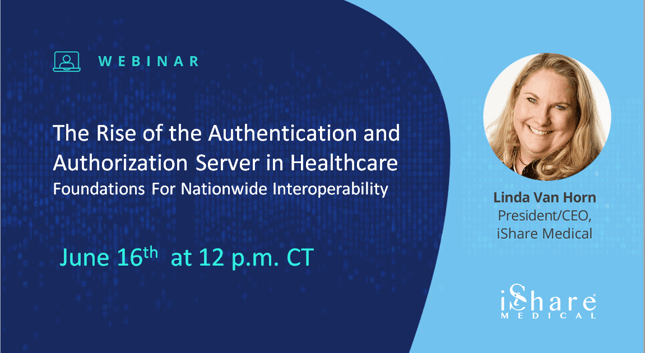
There are 333 million Americans who are treated by more than 6 million healthcare providers that are insured by over 6 thousand insurers that process and maintain data on 1.3 billion healthcare claims annually.
How will healthcare manage to share so much data among patients, providers, and payers while protecting security and privacy by ensuring that only parties who are authorized and authenticated get access to this data?
The solution is in "The Rise of the Authentication and Authorization Server in Healthcare".
Recorded on June 16, 2021 at 12 pm CT.
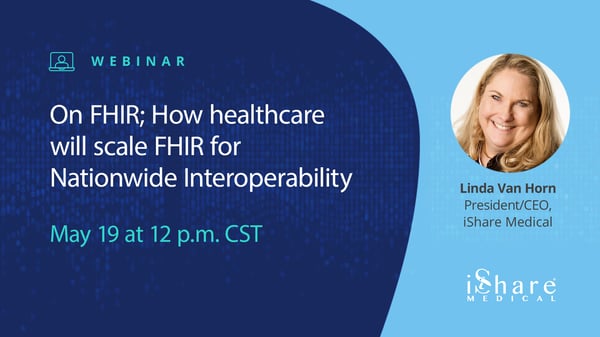
There are 333 million Americans who are treated by more than 6 million healthcare providers whose data is stored on the provider’s electronic medical record system. In addition, there are over 6 thousand insurers that process and maintain data on 1.3 billion healthcare claims annually. How will healthcare payers be able to manage to connect to all these providers and apps?
View this webinar to explore how the healthcare industry is planning to scale FHIR including the seven focus areas of the ONC FAST teams.
Recorded on My 19, 2021 at 12 pm CT.